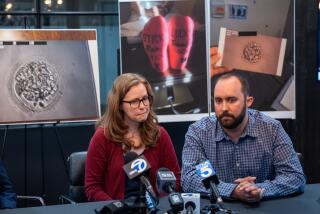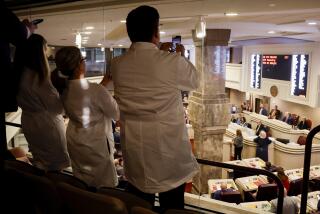Embryos Created for Stem Cell Research
- Share via
WASHINGTON — Inflaming the already heated debate over stem cell research, a team of Virginia fertility researchers report today that it created human embryos for the specific purpose of disassembling them to obtain the valuable stem cells inside.
The experiment, which was legal and used no federal funds, throws a spotlight on one of the murkiest areas of medical research--the creation of human embryos for laboratory experiments--at an unusually sensitive moment. Within weeks, President Bush is expected to announce whether the federal government will fund medical research using embryo stem cells, capping three years of contentious debate.
Several experts said the report, from researchers at the Jones Institute for Reproductive Medicine in Norfolk, Va., appeared to be the first published account of scientists producing embryos only to harvest their stem cells.
They said different teams had probably created embryos for other research purposes, but the practice is not widely discussed because of possible public backlash. The report appears in the July issue of the journal Fertility & Sterility.
Embryonic stem cells can grow into any type of cell in the body, and scientists hope to guide the cells to become replacement tissue for patients--new pancreas cells for diabetics, heart muscle for cardiac patients and brain cells for Parkinson’s patients. But anti-abortion groups say the research is equivalent to murder because human embryos are destroyed in the process of obtaining stem cells.
To date, scientists have obtained stem cells from embryos donated by fertility patients. These patients often create more embryos than needed in the course of trying to have a child.
The government is also eyeing these “spare” fertility clinic embryos as a source of stem cells should Bush approve a funding plan. In lobbying the Bush administration, many scientists and research advocates have argued that it is more ethical to use these embryos in research than to have them discarded or frozen indefinitely, as patients usually do. They have noted that under National Institutes of Health rules, no embryos would be created for the federally funded research.
“Is it more ethical for a woman to donate unused embryos [for research] . . . or to let them be tossed away as so much garbage when they could help save thousands of lives?” asked Christopher Reeve, the actor and a research supporter, in testimony before the Senate last year.
Now, the Jones Institute researchers are adding a new wrinkle to the ethical calculation behind embryo cell research.
In their report, the scientists say they solicited eggs and sperm from paid donors and used them to create 110 fertilized eggs. Forty matured to the stage where stem cells usually develop, though the scientists successfully isolated and cultured cells from only three of them.
Explaining why the research was conducted, the institute’s ethics advisors said, “It was our duty to provide humankind with the best understanding of early human development.” But the work was criticized by people on both sides of the stem cell debate.
“This is really ghoulish, a ghoulish exercise they’ve engaged in,” said Douglas Johnson, legislative director of the National Right to Life Committee, an anti-abortion group.
If Bush approves federal funding for research with “spare” embryos, Johnson said, then scientists in time will demand funding to create embryos for research. “Once the federal government abandons the principle that it will not collaborate in embryo destruction, it has no principled basis for refusing to support these further outrages.”
Richard Doerflinger, an official with the United States Conference of Catholic Bishops, said the experiment “shows the slippery slope in action. Once clinics get used to the idea of research on spare embryos, they will become desensitized enough to consider creating embryos solely to be destroyed.”
Some supporters of embryo cell research criticized the report as well, saying that it was clear from work with fertility clinic embryos that stem cells could be obtained from embryos created for research purposes.
“It seems an unnecessary step, and it certainly raises the ante politically,” said Alexander Capron, a USC professor of law and medicine. “It suggests that the scientists themselves don’t see a reason to abstain from something that seems of marginal medical utility, and which is much more problematic ethically, and is therefore certain to inflame people” who oppose embryo cell research.
Timing of Research’s Disclosure Is Cited
“This is not good timing,” said Dr. Robert Lanza of Advanced Cell Technology Inc., a Massachusetts company working with stem cells and related materials. “They’re throwing gasoline on the fire.”
Others said the new report showed that Bush should support federal funding because it would bring much embryo research under federal ethics and public disclosure rules.
Unless he proposes a change in federal law, Bush’s decision would not bar researchers from repeating the Jones Institute experiment. Even if he prohibits federal funding for the work, research in the private sector would remain untouched. No federal law bars the creation of embryos for research purposes, though some states have sought to regulate the practice.
Dr. William Gibbons, chairman of the department of obstetrics and gynecology at Eastern Virginia Medical School, which houses the Jones Institute, said research findings from the project were announced at a professional meeting last fall, and the paper was submitted in November. He called it an accident of timing that it is being published just as stem cell research has taken a high profile in Washington.
Gibbons said the research was approved by three internal ethics panels, and that the researchers’ method allowed them to select egg and sperm donors who they thought were most likely to produce the healthiest embryos. On average, the 12 women in the experiment were under age 30, compared with ages 34 to 36 for the average fertility patient at the institute.
Moreover, the egg and sperm donors knew from the start that they were contributing to a research project, Gibbons said. By contrast, fertility patients are usually focused solely on their goal of producing a child, and research concerns come as an afterthought.
Finally, Gibbons said, donors in the program were screened for their psychological fitness to participate in the research, whereas fertility patients are usually not screened for that purpose.
“We felt that this was the most straightforward, purest form of informed consent for donors, in that everyone understood the nature of this from the start,” he said.
Research Involving Embryos Highlighted
The release of the report brought attention to the use of human embryos in research that does not involve stem cells. Many bioethicists believe that scientists at private companies and fertility clinics create embryos as part of research into fertility techniques and contraception, but the practice is not widely discussed.
Robert Edwards and Patrick Steptoe, who developed the technique of in vitro fertilization, “created a number of embryos for research purposes only, before they implanted an embryo into a woman,” said Ronald Green, an ethics professor at Dartmouth College. They conducted the research over the course of a decade.
Federal panels have taken different views of the creation of embryos for federally funded research. The practice was endorsed by an advisory panel to the Department of Health and Human Services after the 1978 birth of the world’s first “test tube baby,” Green said. But President Reagan and Bush’s father, George Bush, never put the policy into practice.
In 1994, a special panel of the NIH also endorsed the creation of embryos in limited circumstances for federally funded research, but President Clinton rejected the idea. More recently, the National Bioethics Advisory Commission, created by President Clinton, considered the idea but did not endorse it.
When the NIH last year issued guidelines for the first-ever federal grants for embryo cell research, it said the cells could come only from embryos donated by fertility patients.
The Bush administration put the NIH funding plan on hold this year, pending a review. Bush has said he will announce a decision soon on whether to start or withdraw the funding plan, but he has not announced a timetable.






